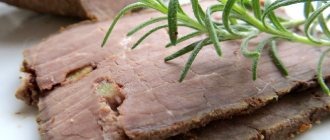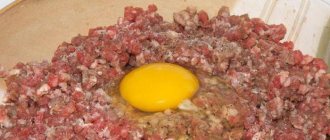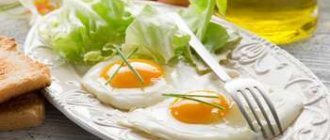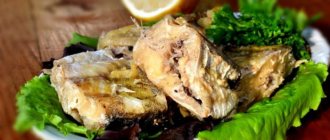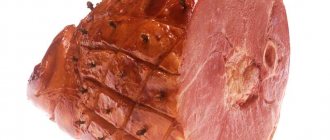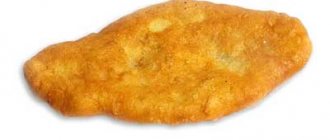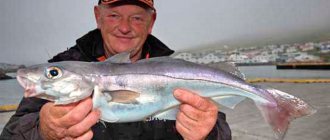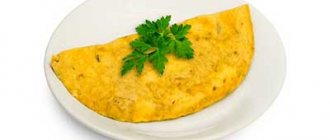Flounder is a commercial fish that is caught in the Baltic and Black Seas. It lives at great depths and has a flattened shape. Fresh fish is greenish in color and the meat is white.
The nutritional value of a product depends on the method of its preparation. Many vitamins and microelements in flounder help restore the body after serious illnesses. Fish is often served as an appetizer, but the list of dishes made from it is also very diverse. What all these dishes have in common is their low calorie content, which characterizes flounder as an extremely valuable dietary product.
- Flounder in dietary nutrition
- The benefits of flounder
- Flounder: calorie content and nutritional value
- Damage to flounder
- What else is important to know about flounder
Flounder as a dietary product
Flounder is an excellent source of protein and contains a huge amount of vitamins, iodine and other important substances that ensure the normal functioning of the body. Cholesterol in the blood does not increase when eating flounder meat, since the fish contains only 3% fat. Moreover, the excellent taste of fish, regardless of the cooking method, will delight any gourmet.
Eating flounder helps burn fat and maintain the body in the necessary tone for people on a diet. For athletes and people who work physically, eating flounder will provide a surge of energy and strength.
Chemical composition and calorie content
The rich chemical composition determines the benefits of the product for human health.
Fish contains:
- vitamins A, B, C, D, E;
- potassium;
- calcium;
- magnesium;
- phosphorus;
- sodium;
- iron;
- iodine;
- zinc;
- fluorine;
- chromium.
Raw nutritional value table:
| Microelements | Contents (per 100 grams) |
| Calorie content | 90 kcal |
| Squirrels | 16 g |
| Fats | 3 g |
| Carbohydrates | 0 g |
| Water | 80 g |
| Cellulose | 0 g |
| Cholesterol | 58 g |
Flounder meat and caviar contain a minimal amount of calories, which can be increased by various cooking methods.
Features of fish depending on preparation
The calorie content of fish varies depending on the cooking method. Most often it is fried, but it is also consumed in other forms - baked, boiled and dried. Energy and nutritional value for different culinary treatments:
| Method of cooking fish | Calorie content per 100 grams | ratio , g | Benefits and harms |
| Fried in a frying pan | 154 kcal | 14/9/4 | Fried fish retains vitamins A, B, E, chlorine, magnesium, nickel, fluorine, and zinc. The harm from such food is that it negatively affects the liver, pancreas, weight |
| Baked in the oven | 62 kcal | 5/2/6 | This is one of the lowest calorie recipes that will not harm your figure and is recommended by nutritionists as a main dish for dinner or lunch. Baked flounder is contraindicated only for people with individual intolerance |
| Boiled | 103 kcal | 18/3/0 | The benefit of fish is that it has a good effect on the digestive system, saturates the body with amino acids, and the dish is allowed as a dietary food. It can cause harm only if you are individually intolerant |
| For a couple | 90 kcal | 16/3/0 | This recipe is practically devoid of carbohydrates, so in addition to it you can add a side dish of vegetables, cereals, pasta that will not harm your figure |
| Dried | 134 kcal | 30/5/0 | Dried fish has a high calorie content; in addition, it negatively affects the functioning of the digestive system. The product is prepared using salt, which is bad for the kidneys. Contraindicated in cases of genitourinary diseases, the presence of salts in the body, fluid retention, or a tendency to hypertension. |
| Caviar | 123 kcal | 20/6/1 | The product is rich in microelements such as vitamins A, D, E, F, lecithin, folic acid. Helps improve brain function, improve the body's protective functions, and normalize the condition of blood vessels. Fried or salty foods can be harmful, so you should eat them in limited quantities. |
What are the benefits of eating flounder?
It has been proven that regular addition of this fish to the diet leads to improved functioning of the gastrointestinal tract, and a beneficial effect on the cardiovascular system has also been noted. This fish also contains iodine, which promotes the correct functioning of the thyroid gland. Omega fatty acids help promote rapid absorption of food. Eating flounder has a beneficial effect on male potency.
The vitamins contained in fish strengthen the body's immune system. Minerals actively affect the functioning of the body as a whole. It is recommended for use by doctors and nutritionists, based on the variety of beneficial substances in its composition.
It is recommended to use flounder for anemia, hypothyroidism, chronic gastritis, cholecystitis and autoimmune diseases.
Flounder recipe in the oven. Calorie, chemical composition and nutritional value.
Nutritional value and chemical composition of “Flounder in the oven.”
The table shows the nutritional content (calories, proteins, fats, carbohydrates, vitamins and minerals) per 100 grams of edible portion.
| Nutrient | Quantity | Norm** | % of the norm in 100 g | % of the norm in 100 kcal | 100% normal |
| Calorie content | 122.4 kcal | 1684 kcal | 7.3% | 6% | 1376 g |
| Squirrels | 17.8 g | 76 g | 23.4% | 19.1% | 427 g |
| Fats | 5.4 g | 56 g | 9.6% | 7.8% | 1037 g |
| Carbohydrates | 0.4 g | 219 g | 0.2% | 0.2% | 54750 g |
| Organic acids | 0.1 g | ~ | |||
| Alimentary fiber | 0.1 g | 20 g | 0.5% | 0.4% | 20000 g |
| Water | 74.3 g | 2273 g | 3.3% | 2.7% | 3059 g |
| Ash | 1.789 g | ~ | |||
| Vitamins | |||||
| Vitamin A, RE | 15.9 mcg | 900 mcg | 1.8% | 1.5% | 5660 g |
| Retinol | 0.016 mg | ~ | |||
| Vitamin B1, thiamine | 0.141 mg | 1.5 mg | 9.4% | 7.7% | 1064 g |
| Vitamin B2, riboflavin | 0.154 mg | 1.8 mg | 8.6% | 7% | 1169 g |
| Vitamin B4, choline | 70.54 mg | 500 mg | 14.1% | 11.5% | 709 g |
| Vitamin B5, pantothenic | 0.196 mg | 5 mg | 3.9% | 3.2% | 2551 g |
| Vitamin B6, pyridoxine | 0.124 mg | 2 mg | 6.2% | 5.1% | 1613 g |
| Vitamin B9, folates | 4.858 mcg | 400 mcg | 1.2% | 1% | 8234 g |
| Vitamin B12, cobalamin | 1.341 mcg | 3 mcg | 44.7% | 36.5% | 224 g |
| Vitamin C, ascorbic acid | 1.63 mg | 90 mg | 1.8% | 1.5% | 5521 g |
| Vitamin D, calciferol | 3.027 mcg | 10 mcg | 30.3% | 24.8% | 330 g |
| Vitamin E, alpha tocopherol, TE | 1.332 mg | 15 mg | 8.9% | 7.3% | 1126 g |
| Vitamin K, phylloquinone | 1.3 mcg | 120 mcg | 1.1% | 0.9% | 9231 g |
| Vitamin RR, NE | 5.2449 mg | 20 mg | 26.2% | 21.4% | 381 g |
| Niacin | 2.099 mg | ~ | |||
| Macronutrients | |||||
| Potassium, K | 351.02 mg | 2500 mg | 14% | 11.4% | 712 g |
| Calcium, Ca | 54.17 mg | 1000 mg | 5.4% | 4.4% | 1846 |
| Silicon, Si | 0.058 mg | 30 mg | 0.2% | 0.2% | 51724 g |
| Magnesium, Mg | 39.99 mg | 400 mg | 10% | 8.2% | 1000 g |
| Sodium, Na | 70.95 mg | 1300 mg | 5.5% | 4.5% | 1832 |
| Sera, S | 212.98 mg | 1000 mg | 21.3% | 17.4% | 470 g |
| Phosphorus, P | 213.2 mg | 800 mg | 26.7% | 21.8% | 375 g |
| Chlorine, Cl | 166.71 mg | 2300 mg | 7.2% | 5.9% | 1380 g |
| Microelements | |||||
| Aluminium, Al | 4.1 mcg | ~ | |||
| Bor, B | 3.8 mcg | ~ | |||
| Vanadium, V | 0.11 mcg | ~ | |||
| Iron, Fe | 0.804 mg | 18 mg | 4.5% | 3.7% | 2239 g |
| Yod, I | 26.77 mcg | 150 mcg | 17.8% | 14.5% | 560 g |
| Cobalt, Co | 22.188 mcg | 10 mcg | 221.9% | 181.3% | 45 g |
| Lithium, Li | 0.229 mcg | ~ | |||
| Manganese, Mn | 0.0617 mg | 2 mg | 3.1% | 2.5% | 3241 g |
| Copper, Cu | 131.03 mcg | 1000 mcg | 13.1% | 10.7% | 763 g |
| Molybdenum, Mo | 4.618 mcg | 70 mcg | 6.6% | 5.4% | 1516 g |
| Nickel, Ni | 6.768 mcg | ~ | |||
| Rubidium, Rb | 0.5 mcg | ~ | |||
| Selenium, Se | 23.053 mcg | 55 mcg | 41.9% | 34.2% | 239 g |
| Fluorine, F | 475.52 mcg | 4000 mcg | 11.9% | 9.7% | 841 g |
| Chromium, Cr | 61.07 mcg | 50 mcg | 122.1% | 99.8% | 82 g |
| Zinc, Zn | 0.5222 mg | 12 mg | 4.4% | 3.6% | 2298 g |
| Digestible carbohydrates | |||||
| Starch and dextrins | 0.2 g | ~ | |||
| Mono- and disaccharides (sugars) | 0.1 g | max 100 g | |||
| Glucose (dextrose) | 0.02 g | ~ | |||
| Sucrose | 0.02 g | ~ | |||
| Fructose | 0.02 g | ~ | |||
| Sterols (sterols) | |||||
| Cholesterol | 62.7 mg | max 300 mg | |||
| beta sitosterol | 2.024 mg | ~ | |||
| Saturated fatty acids | |||||
| Saturated fatty acids | 1 g | max 18.7 g | |||
| 16:0 Palmitinaya | 0.261 g | ~ | |||
| 18:0 Stearic | 0.051 g | ~ | |||
| 20:0 Arakhinovaya | 0.017 g | ~ | |||
| Monounsaturated fatty acids | 1.354 g | min 16.8 g | 8.1% | 6.6% | |
| 16:1 Palmitoleic | 0.031 g | ~ | |||
| 18:1 Oleic (omega-9) | 1.314 g | ~ | |||
| 20:1 Gadoleic (omega-9) | 0.01 g | ~ | |||
| Polyunsaturated fatty acids | 0.267 g | from 11.2 to 20.6 g | 2.4% | 2% | |
| 18:2 Linolevaya | 0.243 g | ~ | |||
| Omega-3 fatty acids | 0.3 g | from 0.9 to 3.7 g | 33.3% | 27.2% | |
| Omega-6 fatty acids | 0.3 g | from 4.7 to 16.8 g | 6.4% | 5.2% |
The energy value of Flounder in the oven is 122.4 kcal.
- Serving = 247 g (302.3 kcal)
Primary Source: Created in the application by the user. Read more.
** This table shows the average levels of vitamins and minerals for an adult. If you want to know the norms taking into account your gender, age and other factors, then use the “My Healthy Diet” application.
Calorie content and nutritional value of flounder
The nutritional value of flounder is attractive to those on a strict diet. It has been proven that even fried flounder does not have a high calorie content per gram, so it is great for those watching their figure. The nutritional value of flounder is 90 kcal per 100 g, and the calorie content per 100 grams of product varies from 61 to 192 kcal in different cooking variations.
Flounder dishes are well absorbed by the body, moreover, they help speed up the process of absorption of nutrients. In this regard, flounder, which is considered low in calories, is recommended for those who watch their figure and adhere to proper nutrition. Looking ahead, we’ll tell you that the calorie content of flounder baked in foil is one of the most acceptable for those who are watching their figure.
| Cooking method | Calorie content per 100 grams | Flounder BJU (proteins, fats, carbohydrates) | ||
| Fried | 110 | 1,5 | 24,2 | 0 |
| In the oven | 61,3 | 5,3 | 1,7 | 0 |
| Dried | 133 | 30,4 | 4,4 | 0 |
| Salty | 162 | 34,8 | 4,7 | 1,5 |
| Smoked | 108 | 17,4 | 2 | 0 |
| Dried | 172 | 34,1 | 3 | 0,8 |
| Hot smoked | 192 | 12 | 22 | 0 |
| Grilled | 160 | 19 | 7,6 | 2,3 |
| Cold smoked | 107 | 16,1 | 3,6 | 0 |
| Boiled | 103 | 18,3 | 3,3 | 0 |
| Baked | 94 | 17,3 | 2,6 | 0,2 |
| For a couple | 90 | 16 | 2,7 | 0,2 |
It is generally accepted that boiled fish contains fewer calories, so people try to enrich their diet with just such a dish. To calculate calories, you can use the following information: the calorie content of boiled flounder is 103 kcal, BZHU 18/3.3/0, for fried flounder the calorie content per 100 grams is 110 kcal, BZHU 1.5/24.2/0. Thus, the value of boiled fish is higher than fried flounder in flour or oil, but less than baked or steamed, as indicated in the table.
The taste of cooked fish is very tender and juicy, it can be served either cold or hot, with any side dish: potatoes, vegetables, rice, bulgur, etc. That's why housewives love this product so much - fish can be cooked every day in a new way.
Cooking flounder if you are not a fan of the strong iodine smell is not recommended.
Calculation of caloric content of a product per 100 grams
The calculation of the calorie content of 100 grams of product is based on previously known indicators of BZHU (abbreviation: proteins-fats-carbohydrates). The calculation method is the summation of these data (obtained by laboratory analysis and calculations) previously multiplied by a value equal to the energy released (calories) during their splitting. So, for example, 1 gram of protein or carbohydrate can release energy equal to 4.1 kcal, and fat a little more than 9. In calorie calculations, these numbers are usually rounded to whole numbers, as is the result itself.
Our example involves proteins - 15.7 grams and fats - 3 grams, contained in 100 grams of product. Next we perform the calculation:
Energy value of 100 grams = 15.7 (proteins)*4 + 3 (fat)*9 = 62.8 + 27 = 89.8 kcal
Our calculated calorie content is more than 50, but less than 250 kcal, which means that flounder is a medium-calorie product with a high protein content, an average level of fat and a low amount of carbohydrates.
Varieties
This type of fish can live in both fresh and salt water. It moves from one body of water to another, lives at the mouths of rivers, and is able to swim from one sea to another through a river. The aquatic inhabitant reproduces only in sea water, despite the fact that some individuals live in rivers the rest of the time.
Fish that live in the seas weigh 7-10 kg, river fish - only 2. There are several types of flounder:
- The white-bellied fish lives in the waters of the Pacific and Atlantic oceans. It has a curved body and a protrusion at the top, exactly in the center.
- Starfish is rare; it prefers to live in places where the sea turns into a river. The difference from other species lies in the eyes, which are located to the left of the usual zone.
- Yellowfin fish is the most common fish and is small in size. It is eaten and bred on an industrial scale.
Benefit
Flounder is allowed to be included in the menu every day. Regular use will help improve the functioning of all body systems, prevent exacerbation of chronic pathologies, and improve overall well-being.
Thanks to this type of fish you can:
- recover from a serious illness;
- strengthen the immune system;
- improve brain function;
- restore psycho-emotional state during depression;
- improve the functioning of the reproductive system;
- improve the condition of the skin, nails and hair;
- reduce the risk of developing dementia (dementia);
- fight diabetes;
- improve the condition of inflammation and arthritis.
The product contains high-quality protein and has virtually no saturated fat. The latter in large quantities increases cholesterol levels, which causes plaques to appear on the walls of the arteries, which lead to the development of myocardial diseases and limit blood flow. Eating fish significantly reduces the amount of cholesterol.
Heart disease experts recommend including baked or fried flounder in your diet at least 2 times a week to reduce blood cholesterol.
For men
The benefits of fish for men's health are great. It consists in:
- improving muscle function;
- increasing mental activity.
The product is an aphrodisiac, therefore it helps to increase libido and normalize the functioning of the reproductive system.
For women
For women, the beneficial properties of the product are important when planning diets, shaping their figure and improving the condition of the skin, hair and nails.
Polyunsaturated fats are especially necessary for maintaining reproductive health.
During pregnancy
Doctors recommend introducing white fish into the diet of pregnant women. This is due to its low calorie content and large amount of protein, which helps the fetus gain optimal body weight. The high content of nutrients contributes to the proper formation and development of the unborn baby, which is especially important in the early stages of pregnancy.
Flounder enhances the body's protective functions and helps the mother cope with infections, viruses, and colds. Iodine and iron are also important for a woman during this period. They help a pregnant woman cope with gestational anemia.

